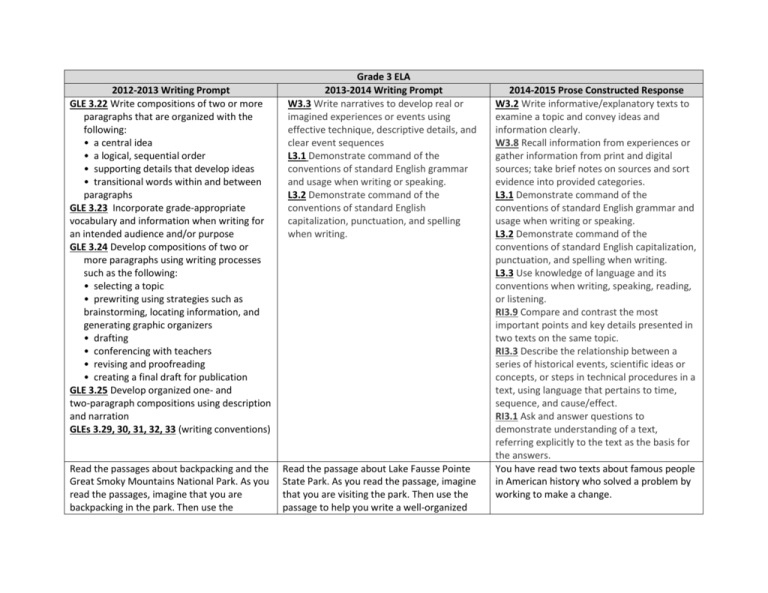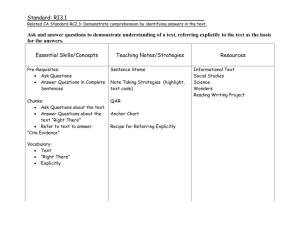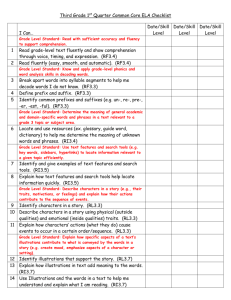Progression of Assessment Items
advertisement

2012-2013 Writing Prompt GLE 3.22 Write compositions of two or more paragraphs that are organized with the following: • a central idea • a logical, sequential order • supporting details that develop ideas • transitional words within and between paragraphs GLE 3.23 Incorporate grade-appropriate vocabulary and information when writing for an intended audience and/or purpose GLE 3.24 Develop compositions of two or more paragraphs using writing processes such as the following: • selecting a topic • prewriting using strategies such as brainstorming, locating information, and generating graphic organizers • drafting • conferencing with teachers • revising and proofreading • creating a final draft for publication GLE 3.25 Develop organized one- and two-paragraph compositions using description and narration GLEs 3.29, 30, 31, 32, 33 (writing conventions) Read the passages about backpacking and the Great Smoky Mountains National Park. As you read the passages, imagine that you are backpacking in the park. Then use the Grade 3 ELA 2013-2014 Writing Prompt W3.3 Write narratives to develop real or imagined experiences or events using effective technique, descriptive details, and clear event sequences L3.1 Demonstrate command of the conventions of standard English grammar and usage when writing or speaking. L3.2 Demonstrate command of the conventions of standard English capitalization, punctuation, and spelling when writing. Read the passage about Lake Fausse Pointe State Park. As you read the passage, imagine that you are visiting the park. Then use the passage to help you write a well-organized 2014-2015 Prose Constructed Response W3.2 Write informative/explanatory texts to examine a topic and convey ideas and information clearly. W3.8 Recall information from experiences or gather information from print and digital sources; take brief notes on sources and sort evidence into provided categories. L3.1 Demonstrate command of the conventions of standard English grammar and usage when writing or speaking. L3.2 Demonstrate command of the conventions of standard English capitalization, punctuation, and spelling when writing. L3.3 Use knowledge of language and its conventions when writing, speaking, reading, or listening. RI3.9 Compare and contrast the most important points and key details presented in two texts on the same topic. RI3.3 Describe the relationship between a series of historical events, scientific ideas or concepts, or steps in technical procedures in a text, using language that pertains to time, sequence, and cause/effect. RI3.1 Ask and answer questions to demonstrate understanding of a text, referring explicitly to the text as the basis for the answers. You have read two texts about famous people in American history who solved a problem by working to make a change. passages to help you write a well-organized story of two or more paragraphs. Imagine you are backpacking in the Great Smoky Mountains National Park. Write a story for your teacher about backpacking in Great Smoky Mountains National Park. Describe the things you might see and what might happen. Use details from BOTH passages to help you tell your story. As you write, follow the suggestions below. • Your story should have two or more paragraphs. • Be sure your story has a beginning, a middle, and an end. • Use details from BOTH passages and include enough information so your teacher will understand what happened in your story. • Be sure to write clearly. • Check your writing for correct spelling, punctuation, and grammar. story of two or more paragraphs. Imagine that you are going on a trip to Lake Fausse Pointe State Park. Write a story for your teacher about a visit you might have to Lake Fausse Pointe State Park. Describe the things you might see and what might happen. Use details from the passage to help you tell your story. As you write, follow the suggestions below. • Your story should have two or more paragraphs. • Be sure your story has a beginning, a middle, and an end. • Use details from the passage and include enough information so your teacher will understand what happened in your story. • Be sure to write clearly. • Check your writing for correct spelling, punctuation, and grammar. Write an article for your school newspaper describing how Eliza and Carver faced challenges to change something in America. In your article, be sure to describe in detail why some solutions they tried worked and others did not work. Tell how the challenges each one faced were the same and how they were different. 2012-2013 GLE 3.17 Demonstrate understanding of information in grade-appropriate texts using a variety of strategies, including: • sequencing events • making predictions using information from texts • making simple inferences and drawing conclusions about information in texts • comparing and contrasting, including story elements (e.g., theme, character, and conflicts) and main points or ideas in informational texts • distinguishing between a main idea and a summary • identifying main ideas of texts Why did the players on Julie’s team look worried? A. They felt tired of playing the game. B. They wanted the season to last longer. C. They hoped the score would be tied. D. They thought they might lose the game. Grade 3 ELA 2013-2014 RI3.2 Determine the main idea of a text; recount the key details and explain how they support the main idea. RI3.1 Ask and answer questions to demonstrate understanding of a text, referring explicitly to the text as the basis for the answers. Which statement best describes the puppy’s mood in the poem? A. The puppy’s mood is usually sad. B. The puppy’s mood is often changing. C. The puppy is in a happy mood around children. D. The puppy is in an active mood in the morning. 2014-2015 RI3.2 Determine the main idea of a text; recount the key details and explain how they support the main idea. RI3.1 Ask and answer questions to demonstrate understanding of a text, referring explicitly to the text as the basis for the answers. Part A: The article includes these details about Eliza’s life: She wrote newspaper articles to tell other about what she saw in Alaska to inform those who had not been there. (paragraph 1) She wrote the first guidebook about Alaska (paragraph 1) She was the first woman to work at the National Geographic society, where she wrote many articles and books. (paragraph 11) What do these details help show about Eliza? a. They show that she shared the benefits of her experiences with others.* b. They show she had many important jobs during her lifetime, but becoming a photographer was one of her proudest moments. c. They show that her earlier travels were more exciting than the work she did later in her life. d. They show that she had a careful plan for everything she did in her life. Part B: Ideas from paragraph 1 and 11 were used to help you learn about Eliza. Click on two other paragraphs that include additional support for the answer in Part A. There are more than two paragraphs that include additional support, but you need to only choose two. 2012-2013 GLE 3.17 Demonstrate understanding of information in grade-appropriate texts using a variety of strategies, including: • sequencing events • making predictions using information from texts • making simple inferences and drawing conclusions about information in texts • comparing and contrasting, including story elements (e.g., theme, character, and conflicts) and main points or ideas in informational texts • distinguishing between a main idea and a summary • identifying main ideas of texts What is the most likely reason the Ice Hotel disappears? A. The workers stop building. B. The weather gets warm. C. The people stop visiting. D. The river begins to freeze. Grade 3 ELA 2013-2014 RI3.3 Describe the relationship between a series of historical events, scientific ideas or concepts, or steps in technical procedures in a text, using language that pertains to time, sequence, and cause/effect. Based on the information in “The Body of an Owl,” what is one effect of the size of the owl’s eyes? A. The owl hunts food best while flying. B. The owl can see only in the dark. C. The owl must turn its head to look around it. D. The owl always has a wide-awake look. 2014-2015 RI3.3 Describe the relationship between a series of historical events, scientific ideas or concepts, or steps in technical procedures in a text, using language that pertains to time, sequence, and cause/effect. RI 3.1 Ask and answer questions to demonstrate understanding of a text, referring explicitly to the text as the basis for the answers. Part A: Which statement best describes how the events in paragraphs 13 through 15 are related to each other? a. They explain how Washington, D.C., would change if cherry trees were planted around the city b. They show that Eliza found a new way to get cherry trees planted in Washington, D.C.* c. They compare the ways Eliza and Mrs. Taft tried to add beauty to Washington, D.C. d. They describe how Mr. Takemine gave Eliza the idea to bring cherry trees to Washington, D.C. Part B: Which sentence from the article best supports the answer in Part A? a. “When they bloomed, the trees became clouds of pink blossoms.” b. “She kept trying for more than twenty years!” c. “She wrote a letter to the president’s wife, Mrs. Taft.”* d. “With the help of Mr. Takamine, a generous Japanese scientist, they had the trees sent from Japan.” 2012-2013 GLE 3.10 Demonstrate understanding by summarizing stories and information, including the main events or ideas and selected details from the text in oral and written responses What is this story about? A. Two friends who win a soccer game B. The official rules for playing soccer C. Two players on different soccer teams D. The best way to score a goal in soccer Grade 3 ELA 2013-2014 RL3.2 Recount stories, including fables, folktales, and myths from diverse cultures; determine the central message, lesson, or moral and explain how it is conveyed through key details in the text. RL3.1 Ask and answer questions to demonstrate understanding of a text, referring explicitly to the text as the basis for the answers. Part 1 What is the central message of this passage? A. Sports help a person stay healthy. B. Hard work can lead to success. C. Games should be played for fun. D. It is necessary to plan ahead. Part 2 Which detail from the passage best supports the central message? A. “I was excited because I love playing soccer,” B. “We had one last chance to change that.” C. “Our team let out another cheer.” D. “Her effort all season had finally paid off.” 2014-2015 RI3.2 Determine the main idea of a text; recount the key details and explain how they support the main idea. RI3.1 Ask and answer questions to demonstrate understanding of a text, referring explicitly to the text as the basis for the answers. Part A: What is one main idea of “How Animals Live”? a. There are many types of animals on the planet. b. Animals need water to live. c. There are many ways to sort different animals. d. Animals begin their life cycles in different forms. Part B: Which detail from the article best supports the answer to Part A? a. “Animals get oxygen from air or water.” b. “Animals can be grouped by their traits.” c. “Worms are invertebrates.” d. “All animals grow and change over time.” e. “Almost all animals need water, food, oxygen, and shelter to live.” 2012-2013 GLE 3.49 Complete simple outlines with main topics and subtopics that reflect the information gathered Look at an outline of “About Bats” from The Encyclopedia of Nocturnal Animals. I. ____________________ A. Large eyes B. Simple ears C. Simple noses II. ____________________ A. Small eyes B. Large ears C. Complexly shaped noses Which information goes in the blank at II? A. Microbats B. Megabats C. Mammals D. Flying foxes Grade 3 ELA 2013-2014 RI3.3 Describe the relationship between a series of historical events, scientific ideas or concepts, or steps in technical procedures in a text, using language that pertains to time, sequence, and cause/effect. RI3.1 Ask and answer questions to demonstrate understanding of a text, referring explicitly to the text as the basis for the answers. How does cutting ice from the river fit into the sequence of events that go into building the hotel? A. It is the first thing that happens in November, just before construction begins. B. It happens throughout the building process to avoid melting. C. It happens much earlier than the other events, taking place months before. D. It happens right after the new set of plans is developed. 2014-2015 RI3.3 Describe the relationship between a series of historical events, scientific ideas or concepts, or steps in technical procedures in a text, using language that pertains to time, sequence, and cause/effect. RI3.1 Ask and answer questions to demonstrate understanding of a text, referring explicitly to the text as the basis for the answers. Drag the four words from the word box into the correct locations on the graphic to show the life cycle of a butterfly as described in “How Animals Live.” 1. 4. 2. 3.








